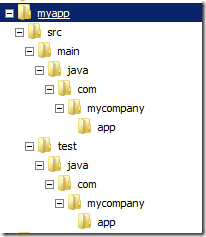创建project
先去官方网站下载一个最新版本http://maven.apache.org/download.cgi. 下载后解压,使用之前最好先将maven的bin目录设置到path环境变量里面。
maven无非也就是用来build一个project的,直接先上一个例子,在命令行下输入下面的命令:
mvn archetype:generate DarchetypeGroupId=org.apache.maven.archetypes -DgroupId=com.mycompany.app -DartifactId=myapp
mvn就是maven的命令行程序,archetype:generate中的archetype是plugin的名字,generate是goal的名字,命令行后面的是一些参数。关于archetype和goal以及后面的参数,后面再细说。
如果是第一次运行,这个过程会有点慢,maven需要下载一些依赖项,中间如果有输入提示信息,直接回车使用默认值就可以了。这条命令执行完后,会在你的当前目录下生成一个名为myapp的目录:
注意这个目录结构,src/main/java 和 src/test/java 是不能改动,不然maven会无法找到源文件。下面是maven一个标准的目录结构:
| src/main/java | Application/Library sources |
| src/main/resources | Application/Library resources |
| src/main/filters | Resource filter files |
| src/main/assembly | Assembly descriptors |
| src/main/config | Configuration files |
| src/main/scripts | Application/Library scripts |
| src/main/webapp | Web application sources |
| src/test/java | Test sources |
| src/test/resources | Test resources |
| src/test/filters | Test resource filter files |
| src/site | Site |
另外maven还生成了一个重要的文件pom.xml,maven就是通过这个文件来来管理整个project,可以理解位类似于eclipse的.project文件。默认生成的pom.xml文件的内容如下:
/* 1-1 */ <project xmlns="http://maven.apache.org/POM/4.0.0" xmlns:xsi="http://www.w3.org/2001/XMLSchema-instance" xsi:schemaLocation="http://maven.apache.org/POM/4.0.0 http://maven.apache.org/xsd/maven-4.0.0.xsd"> <modelVersion>4.0.0</modelVersion> <groupId>com.mycompany.app</groupId> <artifactId>my-app</artifactId> <version>1.1.0.1</version> <packaging>jar</packaging> <name>myapp</name> <url>http://maven.apache.org</url> <properties> <project.build.sourceEncoding>UTF-8</project.build.sourceEncoding> </properties> <dependencies> <dependency> <groupId>junit</groupId> <artifactId>junit</artifactId> <version>3.8.1</version> <scope>test</scope> </dependency> </dependencies> </project>
解释一下这个xml文件的内容:
- modelVersion: 这个XML文件所使用的POM格式的版本
- groupId: 相当于这个project的所有者或者机构的一个标识,一般是com.company.xxx这种格式
- artifactId: 这个project最后所生成的文档(jar、war)的名字,比如对于junit这个开源的project,它的artifactId就是junit
- packaging: 这个project的打包的类型,一般是war、jar等值
- version: project的版本
- name: project的名字,生成文档等内容的时候会用的这个名字
这个project创建好后和普通的project没有什么不同,我们直接往里面放源代码进行开发就可以了,如果有目录想修改的也完全可以。
POM & archetype
archetype就是一个project的模板,上面我们生成的project就是用默认的archetype生成的。如果使用不同的archetype,生成的project结构会有所不同。 一个archetype指明了
- 1) 项目的目录结构以及什么目录是放source code,哪些是放test source code,哪些目录是放resource的。
- 2) 一个默认的pom.xml文件,这个默认的pom.xml文件中的groupId,artifactId,version用占位符表示,在创建project的时候通过参数传进来。
pom.xml文件的POM全称是Project Object Model,这个文件对于maven的使用者来说是一个和maven交互的渠道,pom.xml包含了一个maven project的配置,一个project该如何编译打包,project有哪些依赖项等等。
仔细看一下我们前面创建project的命令:mvn archetype:generate DarchetypeGroupId=org.apache.maven.archetypes -DgroupId=com.mycompany.app -DartifactId=myapp
- 1) archetype:generate, 这是一个maven的plugin,用来从一个archetype创建一个project,关于plugin后面再说。
- 2) DarchetypeGroupId,这个就是指的archetype的groupid,也就是说是用的哪个archetype,或者说用哪个项目模板。
- 3) 后面的两个参数,用来放大pom.xml文件里面,作为当前创建的project的描述信息。
Project创建好了,看如何去编译,直接进入的project的目录,在命令行下:
mvn compile
编译完后maven会创建一个target目录去保存编译结果。 我们需要编译成一个什么样的内容,以及要输出到什么地方等等,都是可以在pom.xml文件里面配置的,但是因为我们目前并没有指定这些内容,所以maven会使用默认值。
我们还可以用maven执行test:
mvn test
第一次执行时,maven会去下载一些依赖项。另外要注意的时,如果我们更改了默认的目录结构,maven会因为找bu到test而无法去执行test。如果只需要编译test可以执行:
mvn test-compile
要把项目打包,执行:
mvn package
mvn会根据pom.xml里面的packaging选项打包成相应的文件。
repository & dependency
maven里面有一个repository的概念,当我们的项目依赖于某个jar时,maven会去repository里面去找。repository分两种,一种是远程的,一种是本地的。如果有几个project都用到junit,我们可以把junit放在repository里面,几个project可以公用,节约存储空间而且方便管理,这个repository的位置可以在pom.xml里面设置。
本地的默认的路径是安装用户的目录下的 .m2\repository 文件夹。如果一个依赖项在本地的repository里面没有,那么maven会去他自己的远程的repository http://repo.maven.apache.org/maven2 去下载后放到本地的repository里面。
也就是说,我们如果我们的project需要要引用一个依赖项,我们只需要在pom.xml文件中进行配置,maven会自动帮我们去引用。 我们之前的创建project里面需要写单元测试,引用到了junit,看pom中的配置:
<dependencies> <dependency> <groupId>junit</groupId> <artifactId>junit</artifactId> <version>3.8.1</version> <scope>test</scope> </dependency> </dependencies>
每一个需要为每一个 dependency 指明groupId,artifactId,version。scope很简单,意思是说我们需要怎么引用,比如我们上面的例子里面设置的是test,意思是说只在test里面引用junit。 但是我们如何知道groupId,artifactId和version呢? 比如我现在想引用log4j,这个几个值怎么填? 可以去http://mirrors.ibiblio.org/maven2/ 上去查找。比如log4j,我们就在上面这个地址加上log4j,也就是http://mirrors.ibiblio.org/maven2/junit/。进去后会有一个maven-metadata.xml,打开就可以知道这些值了然后添加这个dependency了。
如果要把一个project安装到本地的repository里面,可以执行下面的命令:
mvn install
到这里就说完了创建,编译,测试,打包以及安装,大部分的项目也就是做这些事情。
再介绍几个其它命令:
- mvn site : 为你的project创建一个站点
- mvn clean: 清除target目录下的所有文件
- mvn eclipse:eclipse :为project生成eclipse的工程文件和classpath文件
build lifecycle & build phase & goal
maven有一套build的生命周期,是按照一套顺序走下来的,这一套顺序就叫一个生命周期(lifecycle)。maven内置三种生命周期:default, clean 和 site。一个生命周期分为多个build phase,下面是default生命周期全部的build phase:
- validate:validate the project is correct and all necessary information is available.
- initialize:initialize build state, e.g. set properties or create directories.
- generate-sources:generate any source code for inclusion in compilation.
- process-sources:process the source code, for example to filter any values.
- generate-resources:generate resources for inclusion in the package.
- process-resources:copy and process the resources into the destination directory, ready for packaging.
- compile:compile the source code of the project.
- process-classes:post-process the generated files from compilation, for example to do bytecode enhancement on Java classes.
- generate-test-sources:generate any test source code for inclusion in compilation.
- process-test-sources:process the test source code, for example to filter any values.
- generate-test-resources:create resources for testing.
- process-test-resources:copy and process the resources into the test destination directory.
- test-compile:compile the test source code into the test destination directory
- process-test-classes:post-process the generated files from test compilation, for example to do bytecode enhancement on Java classes. For Maven 2.0.5 and above.
- test:run tests using a suitable unit testing framework. These tests should not require the code be packaged or deployed.
- prepare-package:perform any operations necessary to prepare a package before the actual packaging. This often results in an unpacked, processed version of the package. (Maven 2.1 and above)
- package:take the compiled code and package it in its distributable format, such as a JAR.
- pre-integration-test:perform actions required before integration tests are executed. This may involve things such as setting up the required environment.
- integration-test:process and deploy the package if necessary into an environment where integration tests can be run.
- post-integration-test:perform actions required after integration tests have been executed. This may including cleaning up the environment.
- verify:run any checks to verify the package is valid and meets quality criteria.
- install:install the package into the local repository, for use as a dependency in other projects locally.
- deploy:done in an integration or release environment, copies the final package to the remote repository for sharing with other developers and projects.
这些build phase是按照顺序执行的,如果执行后面的build phase,前面的build phase 也会被执行。例如如果执行:
mvn deploy
前面的install、verify一直到validate这些build phase都会执行。
每一个build phase是由goal组成的,一个goal其实就是一个任务,一个goal可以关联到一个build phase也可以不关联到任何build phase 。 不关联到任何phase的goal是可以独立执行的,例如:
mvn clean dependency:copy-dependencies package
上面的命令会导致先执行clean这个phase,然后拷贝依赖项,最后打包。注意,这里clean这个goal是clean这个lifecycle里面的一个goal,所以可以看到不同lifecycle的build phase和goal是可以混合在一起执行的。 如果一个goal被绑定到多个phase上,那么goal就会被执行多次。
phase的顺序是已经固定的,如果一个phase没有绑定到任何goal,那么phase就不会被执行。 一个goal可以通过两种方式绑定到一个phase,一个是指定packaging,另一个就是plugin。
packaging&plugin
plugin就是用来向maven提供goal的。一个plugin里面可以有多个goal,这就是为什么我们在指明goal时,前面会用一个冒号与plugin的名字。
一个plugin自己可以指定自己的goal绑定到哪个lifecycle的哪一个Phase上,另外也可以配置一个goal绑定到哪个phase上。可以在pom.xml里面配置。 看两个配置:
<plugin>
<groupId>org.codehaus.modello</groupId>
<artifactId>modello-maven-plugin</artifactId>
<version>1.4</version>
<executions>
<execution>
<configuration>
<models>
<model>src/main/mdo/maven.mdo</model>
</models>
<version>4.0.0</version>
</configuration>
<goals>
<goal>java</goal>
</goals>
</execution>
</executions>
</plugin>这个就在当前的lifecycle里面添加了一个名字叫java的goal,这goal会根据自己的配置去绑定到一个phase,在phase执行的时候这个goal会执行。并且在这个配置里面,可以指定多个execution来让这个goal执行多次。
看另一个示例配置:
<plugin>
<groupId>com.mycompany.example</groupId>
<artifactId>display-maven-plugin</artifactId>
<version>1.0</version>
<executions>
<execution>
<phase>process-test-resources</phase>
<goals>
<goal>time</goal>
</goals>
</execution>
</executions>
</plugin>这个名为time的goal把自己绑定到了process-test-resource这个phase上。
在默认情况下,并不是所有的phase都绑定了goal,比如clean这个lifecycle是有三个phase的,但是只有其中的一个名为clean的phase默认绑定了一个clean:clean goal,其它两个phase默认没有绑定任何goal。
之前已经提到过packaging,在pom.xml可以指定packaging,每种packaging都设定了一组phase和goal之间的绑定关系。在default lifecycle下,当packaging为 ejb/ejb3/jar/par/rar/war 其中之一的值的时候,只有以下的phase绑定了goal,具体如下:
| process-resources | resources:resources |
| compile | compiler:compile |
| process-test-resources | resources:testResources |
| test-compile | compiler:testCompile |
| test | surefire:test |
| package | jar:jar |
| install | install:install |
| deploy | deploy:deploy |
总结
首先搞清楚maven的project的目录结构,然后理解maven的lifecycle,lifecycle是由build phase组成,每一个build phase会绑定到goal。goal是由plugin提供的。 每一种packaging的值都表明了一定的phase和goal之间的绑定关系。
另外一个很重要的就是dependency,我们要在项目中引用一个依赖,只需要在pom.xml指定依赖的名字和版本,maven会自动去远程的repository下载,然后放到本地的repository里面,这样以后所有的project都可以共用





